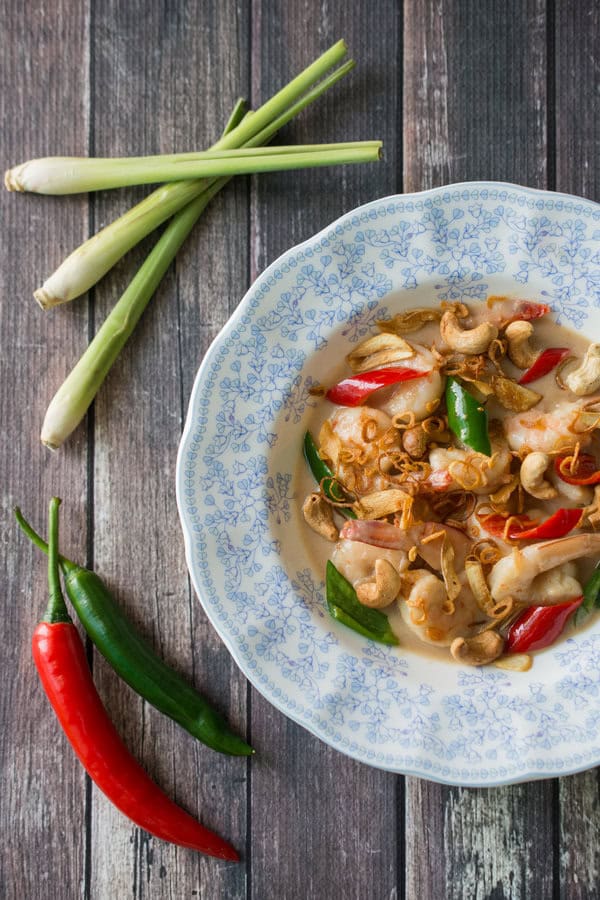
Nyonya Sambal Goreng is not to be confused with Indonesian Sambal Goreng. Nyonya is a blend of the Chinese and Malay cultures here in Malaysia. The blend of these cultures can be clearly seen in Nyonya cuisine where Chinese and Malay ingredients as well as cooking techniques are intermingled to form truly unique recipes.
Nobody really knows why this dish is called Sambal Goreng (literally translated "fried sambal"). The sauce does not have any sambal in it and is not spicy. The only spiciness comes from the chilies used as a garnish. The sauce is ridiculously flavorful and so addicting. Earthy lemongrass mixed with a savory shrimp paste and creamy coconut milk.
(Scroll to the bottom for a printable recipe)
Please note that although I walk you through each step of making this dish, I highly recommend that you read through this post first, then have all of your ingredients ready before you start cooking (i.e. - have all of your lemongrass, garlic, shallots, chilies, etc chopped up before turning on your stove)
Start by soaking 1 tablespoon of fresh tamarind in ½ a cup of water. Press it with your fingers a few times to soften it a little.
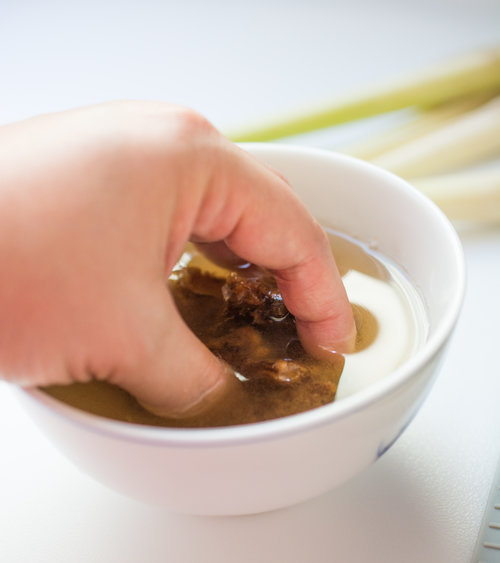
While waiting for the tamarind to soak, roast ½ a cup of raw cashew nuts over low heat in a wok or a frying pan. No oil needed. Just keep stirring so they don't get too dark on one side. As soon as they turn a nice golden color, remove them from the wok and set them aside to let them cool. They will be used as a garnish, but still a crucial ingredient in this dish.
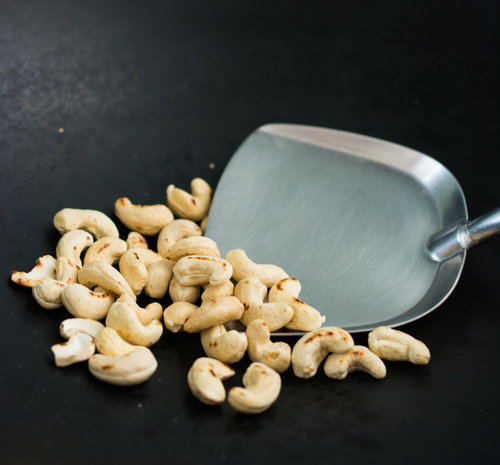
Next, we're going to thinly slice 3 stalks of lemongrass. Each lemongrass stalk is quite tall, but you're only going to use the bottom white-ish portion. The rest of the stalk is going to be too fibrous. You can save it to steep in your tea if you wish. Cut off and discard about ½ an inch from the root, then thinly slice the rest of the white portion of the stalk.
Most Nyonya dishes take a very long time to prepare if done the traditional way but thanks to today's technology, most Nyonya dishes can now be prepared very quickly. With this dish, for instance, a Mortar and Pestle were traditionally used to pound the lemongrass into a paste for the sauce. As you can imagine, this can be very time consuming (and exhausting!)
I use a Magic Bullet Blender for this task. Hardly any effort at all compared to pounding it with a Mortar and Pestle, and it breaks up the lemongrass fibers really well so I get a silky smooth sauce.

Place the sliced lemongrass into a blender cup or food processor, then add 1 tablespoon of belacan(Malaysian shrimp paste...pronounced buh-lah-chan). Belacan
is usually sold in a block or brick form. For convenience, I cut it up into cubes, then dry-roast it in a wok till it becomes little granules. I can then store these granules in a jar to keep in the fridge. Belacan has got a very strong pungent smell (the strongest smelling ingredient in Malaysian cooking; aside from the durian fruit). If you are roasting belacan, be sure to open all your windows before putting this on the stove 🙂 It smells strong and very weird; but once it's cooked, it mellows out quite a bit and gives a lot of dishes such amazing flavor. I recommend trying to find Roasted Belacan
so you can save this step of roasting it yourself.
You can try Tra Chang brand Thai Shrimp Paste which is a good substitute. You may also visit your local Asian supermarket and ask for "terasi". A lot of Indonesian dishes also use shrimp paste and they are usually sold in a bottle, which makes it very convenient to store.

Press the tamarind a few more times to release more juice, then pour all of the juice into the blender cup. Use your fingers as a strainer to catch any seeds or pulp. Don't use a mesh strainer for this task as the tamarind will clog it up.

Blend this sauce mixture for about a minute or until the paste is smooth then set it aside.
Next, we're going to prepare the shallots and garlic. Cut 5 - 6 small shallots and 3 cloves of garlic into very thin slices. Almost paper thin. Pour ¼ cup of cooking oil in a wok, then turn on the heat to medium-low. Before the oil gets hot, toss in the shallots then turn up the heat to medium.
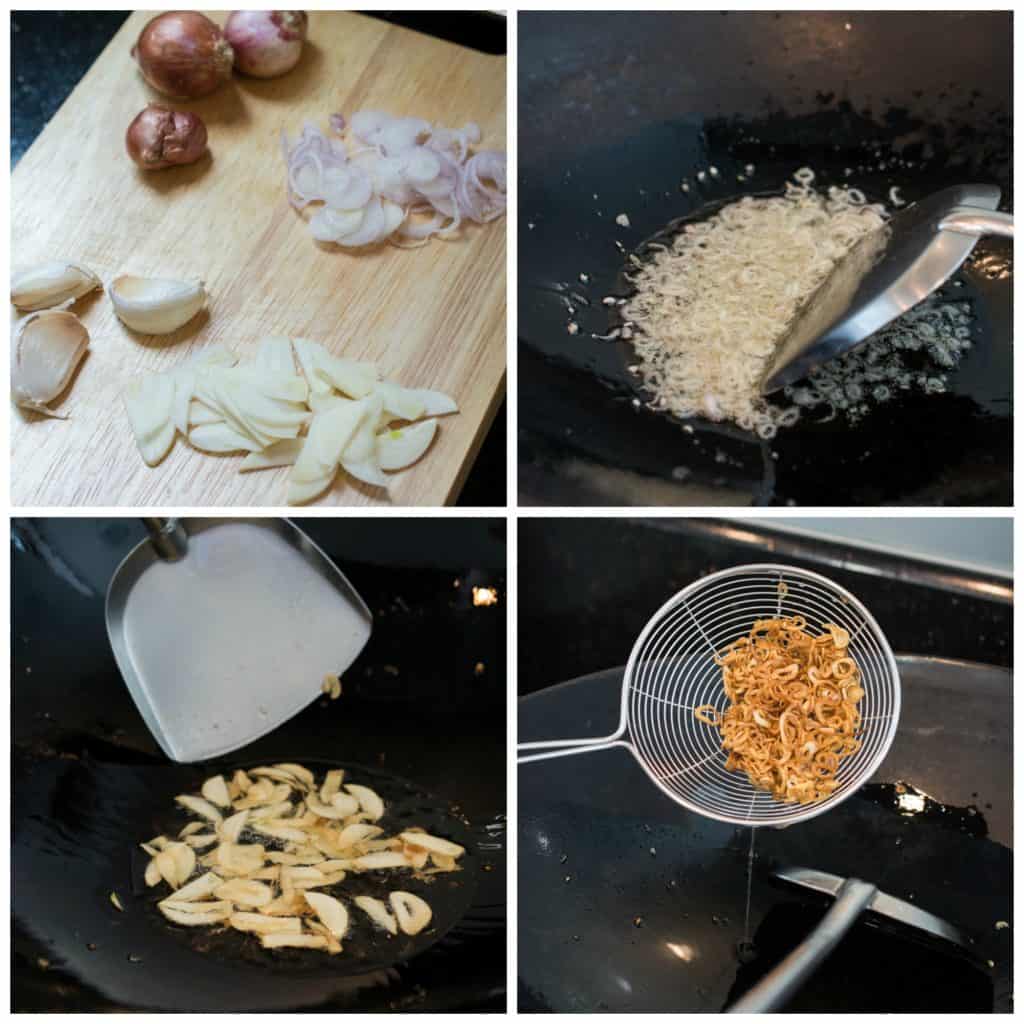
Would you like to save this?
Then take them out with a Spider Skimmer when they are just about golden brown. Spread them out on a paper towel so that the towel can soak up the excess oil. As soon as you remove all of the shallots, add the garlic to the oil and fry the garlic slices until golden brown. Set them both aside for now. They will crisp up nicely.
Remove the oil from the wok using a wok spatula. Turn up the heat to medium high, then stir-fry 1 green chili and 1 red chili (both de-seeded and chopped into large pieces) for just a few seconds. Remove the chili and set aside.
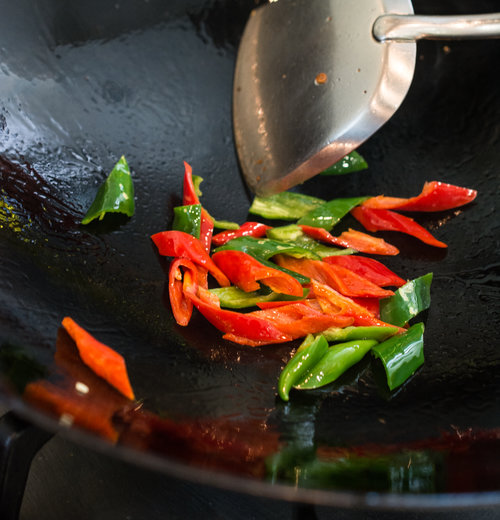
Add 1 tablespoon of oil to the wok, then toss in a pound and a half of shrimp (peeled and deveined, tail on). Stir-fry the shrimp for about a minute, then remove it from the wok to prevent them from over-cooking. Keep the heat on medium-high.
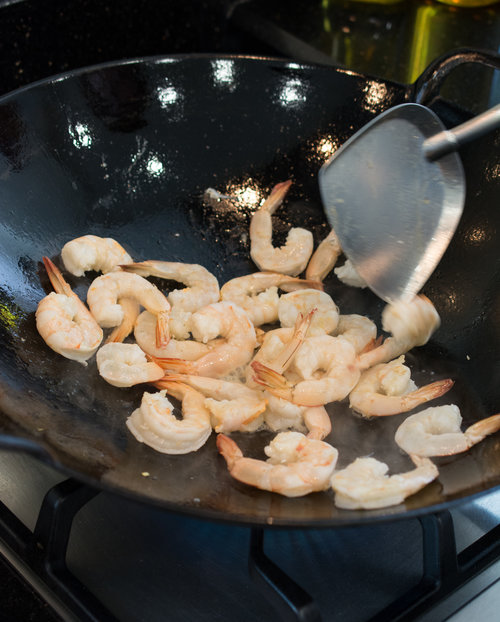
Now, it's finally time to put it all together! Pour the lemongrass sauce in to the wok and let it simmer for about a minute. Keep stirring to prevent it from splattering. As soon as it starts to bubble at the sides, add 1 cup of coconut milk mixed with ½ a cup of water.
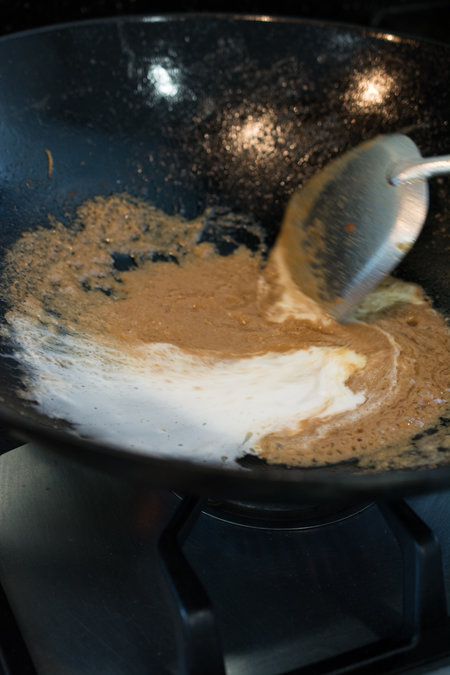
Add the shrimp back in and give it a good stir. Add 2 tablespoons of sugar and 1 teaspoon of salt (or more to taste).
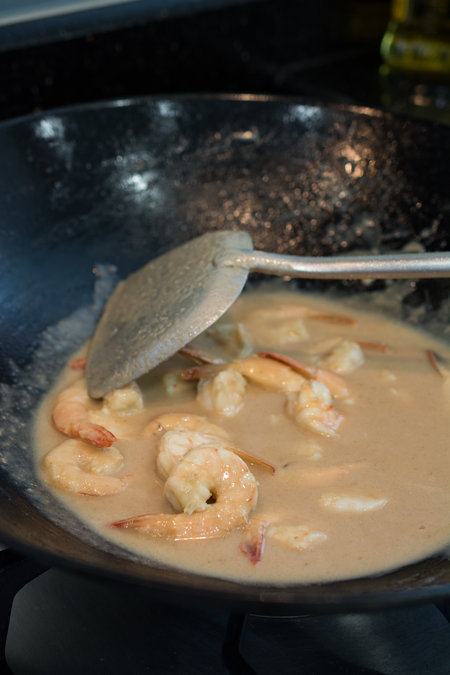
Transfer the sauce and shrimp on to a serving bowl. Top with red and green chilies, roasted cashew nuts, fried shallots and fried garlic slices. Serve with steamed white rice.
Enjoy!

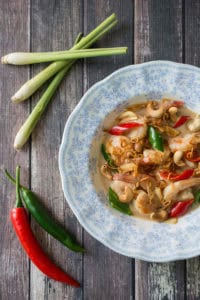
Nyonya Sambal Goreng (Creamy Lemongrass Shrimp)
Ingredients
- 1 tablespoon tamarind paste
- ½ cup water
- ½ cup raw cashew nuts
- 3 stalks lemongrass thinly sliced
- 1 tablespoon belacan shrimp paste, roasted
- ¼ cup cooking oil
- 5 - 6 small shallots thinly sliced
- 3 cloves garlic thinly sliced
- 1 red chili
- 1 green chili
- 1 ½ lbs shrimp peeled, deveined, tail-on
- 1 cup of coconut milk mixed with ½ a cup of water
- 2 tablespoons sugar
- 1 teaspoon salt
Instructions
- Soak the tamarind in water. Gently press with your fingers for a few seconds, then set aside.
- Roast the cashew nuts in a dry wok or frying pan until golden brown. Set aside.
- Put the sliced lemongrass and belacan in a blender cup or food processor.
- Gently press the tamarind to render more juice. Using your fingers as a strainer, pour all of the juice into the blender cup. Blend the mixture until it becomes a smooth paste. Set aside.
- Pour the cooking oil in to your wok, then turn the heat to medium-low. Before the oil gets hot, toss in the sliced shallots. Stir constantly. After about a minute, turn up the heat to medium and keep stirring until the shallots turn a nice shade of light golden brown. Remove them from the wok using a spider strainer. Spread them out on a piece of paper towel to let them cool and crisp up.
- Toss in the sliced garlic and keep stirring until they start to turn golden brown as well. Remove them from the wok and place them with the fried shallots.
- Using a wok spatula, remove as much oil as you can from the wok, then stir-fry the red and green chilies for just a few seconds. Remove and set aside.
- Add 1 tablespoon of oil into the wok and stir-fry the shrimp for about a minute. Remove and set aside.
- Pour the lemongrass sauce into the wok and let it simmer. As soon as it starts to bubble at the sides, add the coconut milk mixed with water. Give it a good stir.
- Add the shrimp back into the wok and stir well.
- Add sugar and salt.
- Transfer the shrimp and the sauce on to a serving plate or bowl.
- Garnish with roasted cashew nuts, red and green chili, fried shallots and fried garlic slices. Serve immediately with steamed rice.
- Enjoy!
Nutrition


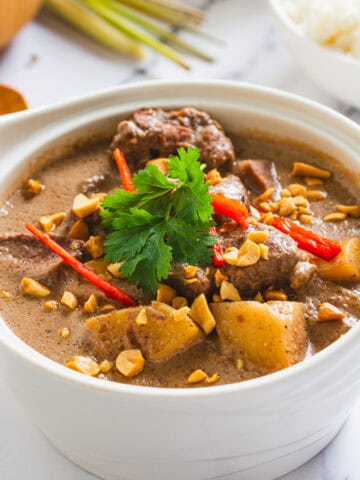
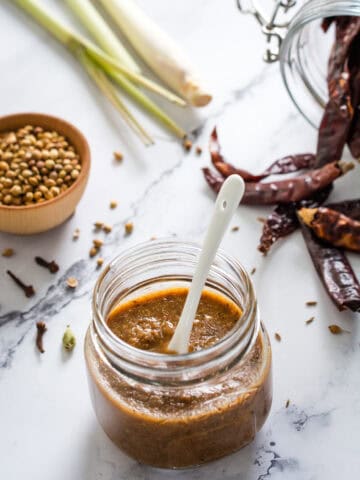
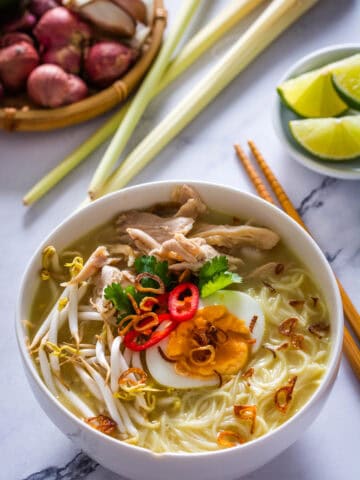
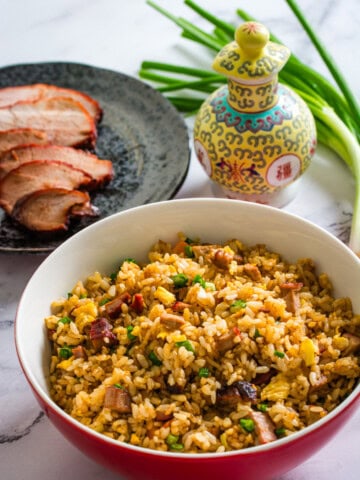
Leave a Reply